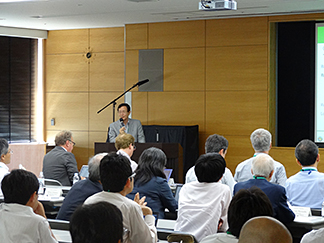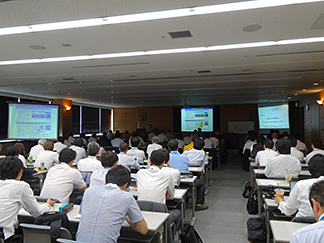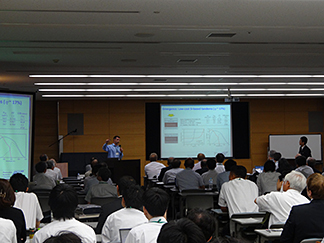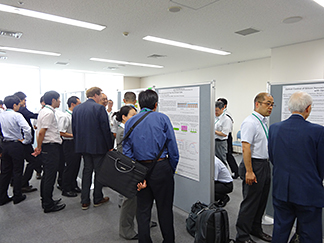The 2nd International Symposium on “Nano-Wire Si Solar Cells” of MEXT “FUTURE-PV Innovation” Project
In MEXT’s FUTURE-PV (Fukushima Top-level United center for Renewable Energy research-PhotoVoltaics) Innovation Project, the 2nd International Symposium on “Nano-Wire Si Solar Cells” was held in the Large Conference Room of Koriyama Civic Plaza in Fukushima Prefecture on July 22 and 23, 2014. The symposium was organized by JST as the Support Institution for establishment of research center and co-organized by Koriyama City.
The research and development resources for the project were got together to Fukushima Renewable Energy Institute, AIST which was opened in Koriyama City in April this year. Accordingly, the place for the symposium was moved from Tokyo where it had been held at the previous time, to Koriyama City.
In opening address, before and after organizer greeting by JST Executive Director Shoichirou Tonomura, we got words of encouragement and hope from Deputy Director-General of Research and Development Bureau of MEXT, Mayor of Koriyama City and Member of Council for Science, Technology and Innovation/Professor of The University of Tokyo. After opening address, Professor Makoto Konagai of Tokyo Institute of Technology who was the Research Director of the project gave an overview of FUTURE-PV Innovation Project.
Latest achievements were presented by three Team Leaders of this project, Dr. Kazuo Nakajima of JST, Associate Professor Shinsuke Miyajima of Tokyo Institute of Technology and Dr. Yukimi Ichikawa of JST. The presentation by each teams demonstrated that results of the research were gotten steadily. Concretely, improvement of the lifetime of silicon by Noncontact Crucible Method was reported by Team 1, growth of Si nanowires by Superlattice Method and Template Method by Team 2, and fabrication of Si nanowall of 1.5nm wide for the top cell and realization of the open-circuit voltage of 720mV in Si heterojunction cells for the bottom cell by Team 3.
Then, by Deputy Director-General of Fukushima Renewable Energy Institute, AIST, research activities of the Institute were introduced.
By six researchers from overseas who were on the cutting-edge in the field of solar cells, Professor of University of Stuttgart, Associate Professor of Massachusetts Institute of Technology, Vicechairman, Scientific Council of Academy of Sciences of the Czech Republic, Professor of Delft University of Technology, Manager of Interuniversity Microelectronics Centre and Professor of Eindhoven University of Technology, presentations were given. The presentations included research for cost reduction, such as cost calculation of Si solar cells and reduction of impurity in Si wafer, and the new information toward the high-efficiency performance, such as effect of light confinement by nano structure, theoretical calculation of nano array structure solar cells and Si heterojunction cells with thin wafer.
After that, in the poster session, 18 posters were presented from groups of FUTURE-PV project. They showed the latest results of research on elemental technology for nanowire solar cells. Exchange of ideas and opinions was carried out actively.
As a large number of persons from domestic and international fields of industry, academic and government participated this symposium, about 110 participants including the researchers of the project, administrative agency persons that promoted Fukushima Reconstruction joined. Site visit was held at Fukushima Renewable Energy Institute, AIST before the symposium, and about 30 participants visited the new research and development facility. In continuation of the 1st Symposium, the 2nd symposium enabled us to grasp the latest status of the leading-edge of research and development in the field of solar cells and to obtain the clue for enhancing the activity of research. At the same time, the symposium impressed the real start of the research center by holding it in Koriyama.
The outline and program are here.




